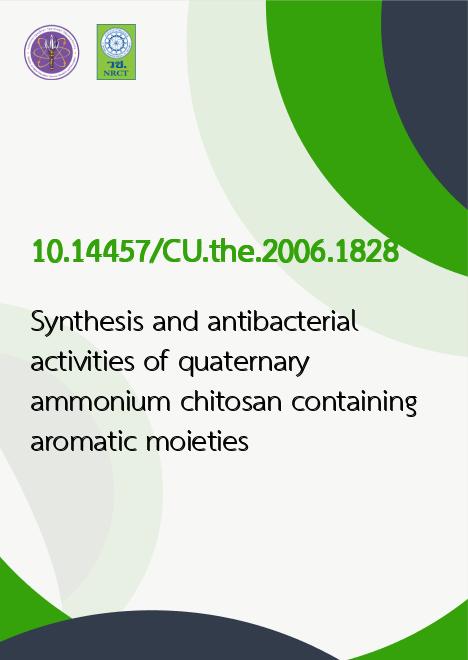
|
Synthesis and antibacterial activities of quaternary ammonium chitosan containing aromatic moieties |
|---|---|
| รหัสดีโอไอ | |
| Title | Synthesis and antibacterial activities of quaternary ammonium chitosan containing aromatic moieties |
| Creator | Warayut Sajomsang |
| Contributor | Supawan Tantayanon, Daly, William H., Varawut Tangpasuthadol |
| Publisher | Chulalongkorn University |
| Publication Year | 2549 |
| Keyword | Antibacterial agents, Chitin, Chitosan |
| Abstract | The 52 N-octyl and N-benzyl chitosans bearing quaternary ammonium salts were successfully synthesized by either N-alkylation or N-benzylation of chitosan and then quaternization. The extent of N-substitution (ES) was influenced by the molar ratio of the aldehyde to amino group of chitosan, the reaction time and the substituent on the benzene ring. Quaternization was carried out by using either iodomethane or 3-chloro-2-hydroxypropyl trimethylammonium chloride (Quat-188). The low degree of quaternization (DQCh) of chitosan was obtained with single treatment using iodomethane. The repeated methylation with iodomethane would increase not only DQCh but also degree of O-methylation at 3-hydroxy and 6-hydroxy groups of chitosan. For quaternization using Quat-188, O-alkylation was not observed. When ES increased, DQCh decreased obviously due to less free amino group of chitosan reacting with Quat-188. Moreover, the DQCh of N-benzyl chitosans using Quat-188 was always higher than using iodomethane at the same level of ES. All quaternary ammonium salts of chitosan using Quat-188 were highly water soluble at neutral pH. Minimum inhibitory concentration (MIC) antibacterial studies of these materials were carried out on E. coli (Gram-negative) and S. aureus (Gram-positive) bacteria. All quaternized chitosan derivatives showed very low MIC values which was in the range of 8-128 g/mL against both bacteria. The quaternization of chitosan using either iodomethane or Quat-188 was also performed for comparison. |
| URL Website | cuir.car.chula.ac.th |